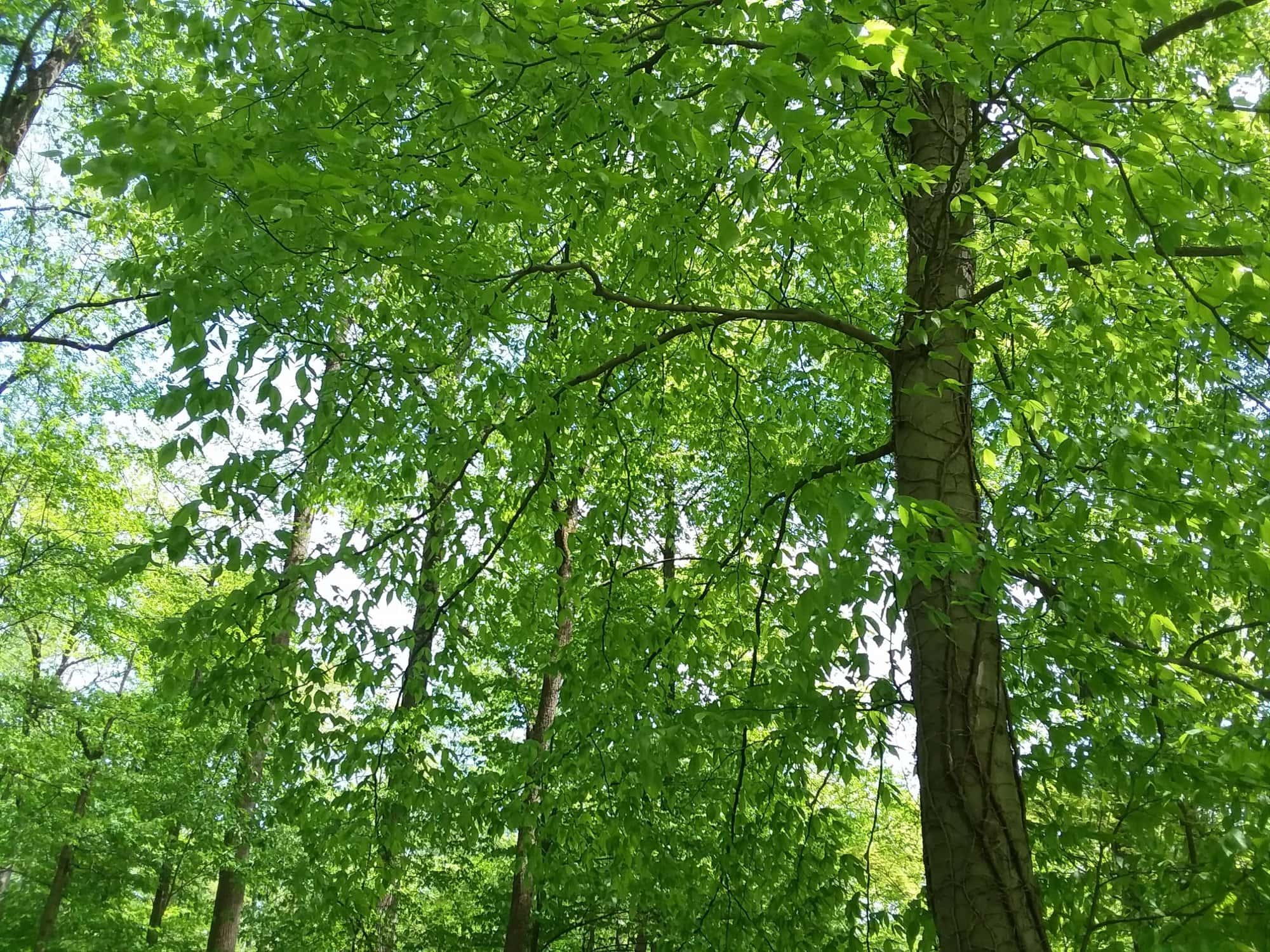Canopy of trees limits the amount of sun on the lawn.
Confessions of a Schwenksville, PA Homeowner Who Wanted Both – Trees and Lush, Green Lawn.
Guest blogger, Rosemary and Sam Whitehouse, parents of Sam and Ted Whitehouse who are owners of Whitehouse Landscaping, have lived on a beautiful wooded lot for over 40 years.
Growing grass in the shade is a constant struggle for homeowners. Many fight the shady conditions and are unwilling to accept the reality that you can’t have a beautiful lawn as well as beautiful trees. We know from experience, because we’re one of those homeowners. We’ve lived on a shaded property for over 40 years and have never totally accepted that we couldn’t have a lush, green lawn. Even having two sons who are in the landscaping business and one who is a Certified Turf Specialist, we still had hope that they could perform a miracle.
Why Growing Grass in the Shade is Tough
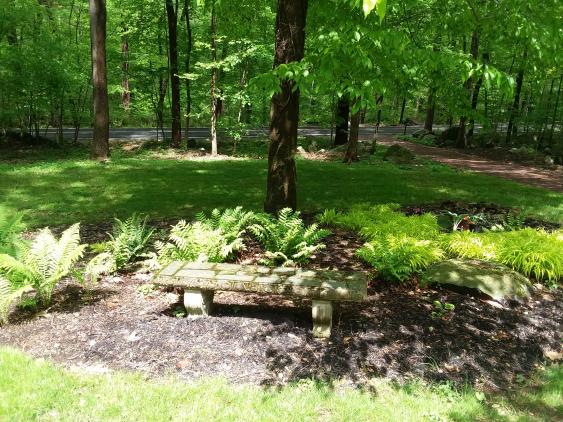
A mulched, landscaped bed with shade loving plants.
Turf grass is a sun loving plant that grows best with a minimum of 6 hours of direct sunlight. Think about it, it’s rare to find turf growing in a forest. Trees have extensive root systems (often shallow) that demand huge amounts of water and nutrients. They also have dense leaves that severely restrict the sun from getting through to the grass. So that’s it in a nutshell – competition for water, nutrients, and light are the three primary reasons for grass failure under shaded conditions.
Moss also takes over due to poor drainage providing additional lawn competition. Moss doesn’t actually kill the grass but rather begins to invade a shady area because the grass tends to thin out.
Weeds like wild violets and other shade-loving weeds will invade shady areas because the grass once again thins out and conditions are more favorable for weeds to grow. The good news is that you’ll never have to deal with crabgrass because that weed specifically needs sun to thrive.
How to Improve Conditions and Improve Your Chances of Success
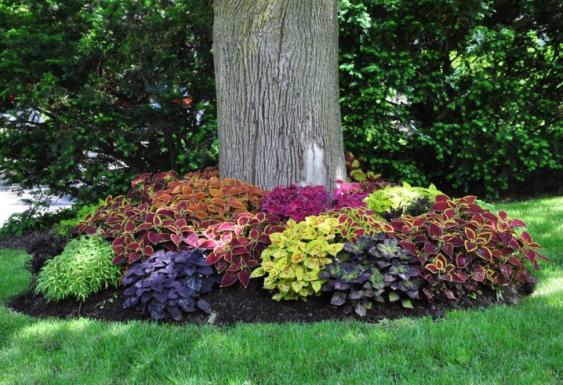
Vibrant coleus planted at base of tree. Image via: threedogsinagarden.blogspot.com
Increase sunlight. Since all grass requires sunlight to grow properly, the easiest and most effective solution is to eliminate some of the shade. Prune tree branches as much as possible without destroying the function and beauty of the tree. Or a more drastic measure could be to remove one or more of your trees that are not significant players in the beauty of your landscape. Hire the services of a train arborist who will safely and selectively prune to reduce your tree canopy which is the major stress on turf. Whitehouse Landscaping offers professional and customer-oriented tree services to residents in Montgomery, Chester and Berks counties.
Use shade tolerant grass. Even the most shade tolerant grasses require a minimum of four hours of direct sunlight daily. If a lawn receives a minimal amount of sunlight, it’s not going to survive, let alone thrive. Extra effort is required to grow grass in the shade.
Consider aerating and overseeding in the fall. This may help, but again, it depends just how much sunlight you are receiving. Read more about aeration and overseeding.
Think Out of the Box and Try Some Alternatives
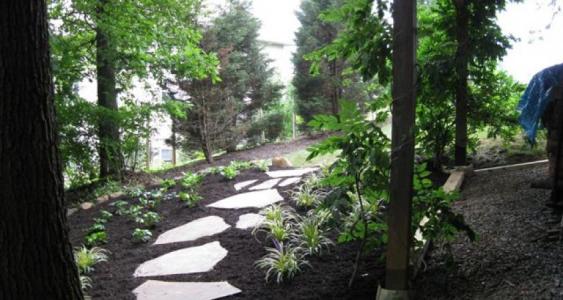
A shaded property in Birdsboro with stepping stones and mulch.
Create more landscaped beds. Design a curved landscaped bed which will add aesthetic interest and curb appeal. There are many shade-loving plants and interesting plant combinations that will thrive where grass will not. Shade tolerant groundcovers (such as pachysandra and periwinkle) along with mulch will also do the trick. The visual appeal of a landscaped bed will cause you to miss your lawn less.
Spread mulch from the base of the tree. Over time, the mulch will smother any competing grass.
Create a Focal Interest. Instead of making your lawn the main focal point, create a different landscape enhancement as a focal point that will draw the eye and grab your attention. Perhaps a few boulders within a landscaped bed, a few colorful container plantings or some well-designed hardscaping.
A patio is always a place that families and friends gather. A patio with a water feature or fire feature can help you get the full enjoyment out of your yard and you’ll never miss the perfect grass. Most homeowners would love to have some shade on their patio instead of the blazing hot sun all day.
Don’t Fight Your Lawn – Embrace It
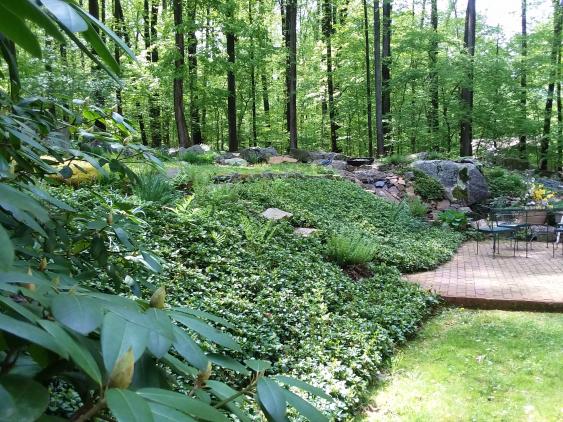
Bank of pachysandra thrives in the shade.
The sooner you come to terms with the fact that there’s only so much you can do about growing grass in the shade, the happier you will be. Certainly, all hope is not lost but you must understand the basics of how to grow grass in the shade.
We decided to build our house on our lot because we fell in love with the beautiful trees. We love their beauty in the spring, winter and fall and especially love the shade they provide in the hot summer months. Mature trees are an asset for any home, adding value to the property and reducing energy. However, every silver lining has a downside. Mature trees bring the challenge of growing grass. Although our yard isn’t thick and green, the trade-off is the enjoyment that we have received from our trees all these years. Maybe it’s maturity setting in, or it just took a long time to accept our lawn for what it is. But either way, we have come to terms that our shaded lawn is the best it can be and we focus on how much we love our trees.
We recommend Whitehouse Landscaping to help you create your perfect outdoor living area. Regardless of how much – or little – sun your yard gets, they will work with your property and customize a plan that works best for you. Call 484-300-4290 or contact us on our website.

